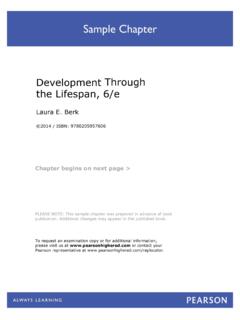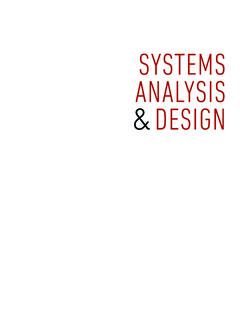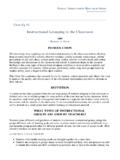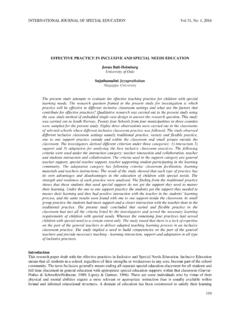Transcription of Methods for Effective Teaching - Pearson
1 Methods for Effective TeachingEighth EditionPaul R. BurdenKansas State UniversityDavid M. ByrdUniversity of Rhode IslandMEETING THE NEEDS OF ALL STUDENTS330 Hudson Street, NY 110/30/17 4:10 PMISBN 10: 0-13-469574-7 ISBN 13: 978-0-13-469574-7 Director and Publisher: Kevin DavisExecutive Portfolio Manager: Drew BennettManaging Content Producer: Megan MoffoContent Producer: Yagnesh JaniPortfolio Management Assistant: Maria Feliberty and Casey CoriellExecutive Product Marketing Manager: Christopher BarryExecutive Field Marketing Manager: Krista ClarkManufacturing Buyer: Deidra SmithCover Design: Jessica Chernyak, Studio MontageCover Art: Klaus Vedfelt/DigitalVision/Getty ImagesMedia Producer: Lauren CarlsonEditorial Production and Composition Services: SPi Global, 2019, 2016, 2013, 2010, 2007 by Pearson Education, Inc., or its affiliates. All rights reserved. Printed in the United States of America. This publication is protected by Copyright, and permission should be obtained from the publisher prior to any prohibited reproduction, storage in a retrieval system, or transmission in any form or by any means, electronic, me-chanical, photocopying, recording, or likewise.
2 For information regarding permissions, request forms and the appropriate contacts within the Pearson Education Global Rights & Permissions department, please visit of third-party content appear on the page with the content, which consti-tutes an extension of this copyright otherwise indicated herein, any third-party trademarks that may appear in this work are the property of their respective owners and any references to third-party trademarks, logos or other trade dress are for demonstrative or descriptive purposes only. Such references are not intended to imply any sponsorship, endorsement, authorization, or promotion of Pearson s products by the owners of such marks, or any relationship between the owner and Pearson Education, Inc. or its affiliates, authors, licensees or of Congress Cataloging-in-Publication DataNames: Burden, Paul R., author. | Byrd, David M., : Methods for Effective Teaching : meeting the needs of all students / Paul R.
3 Burden, Kansas State University, David M. Byrd, University of Rhode : Eighth edition. | Hoboken : Pearson Education, Inc., [2019]Identifiers: LCCN 2017040176| ISBN 9780134695747 | ISBN 0134695747 Subjects: LCSH: Teaching . | Effective : LCC .B87 2019 | DDC LC record available at 210/30/17 4:10 PMiiiPaul R. Burden is an assistant dean and professor in the College of Education at Kansas State University, Manhattan, where he has supervised student teachers and taught courses on Teaching Methods , classroom management and disci-pline, foundations of education, and instructional leader-ship. Currently, he is the college s accreditation coordinator. Previously, he was a middle-level science teacher in Buffalo, New York, and later earned his doctoral degree at The Ohio State University. He has received the College of Education s Outstanding Undergraduate Teaching Award at Kansas State University and the Distinguished Service award from the National Staff Development publications include Classroom Management: Cre-ating a Successful K 12 Learning Community (2017, John Wiley & Sons), Countdown to the First Day of School (2006, National Education Association), Powerful Classroom Management Strategies: Motivating Students to Learn (2000, Corwin Press), as well as Establishing Career Ladders in Teach-ing (1987, Charles C Thomas).
4 He served for 11 years as the editor of the Journal of Staff Development, a quarterly journal sponsored by the National Staff Development Council, and he has presented over 70 papers at regional and national educational conferences in addition to authoring 15 articles and four book with three children, Dr. Burden enjoys traveling with his family and working on genealogy. He can be contacted at Kansas State University, 7 Bluemont Hall, Manhat-tan, Kansas 66506; 785-532-5595; M. Byrd is director of the School of Education at the University of Rhode Island. He is a graduate of the doctoral program in teacher education at Syracuse University. Prior to coming to Rhode Island, he was an associate professor at Southern Illinois University. He has a long-term professional and research interest in programs for beginning teachers and teacher professional Byrd has authored and co-authored over 30 articles, books, and chapters. He has served as co-editor of the As-sociation of Teacher Educators Teacher Education Yearbook series (2000 2006).
5 Yearbook titles that he edited include Preparing Tomorrow s Teachers: The Field Experience, Re-search on the Education of Our Nation s Teachers, Research on Career Long Teacher Education, Research on Professional Development Schools, and Research on Effective Models for Teacher Education. He has served as chairperson of the Research Committee for the As-sociation of Teacher Educators and on the journal board for Action in Teacher Education. Dr. Byrd can be contacted at the University of Rhode Island, 706 Chafee Hall, Kingston, Rhode Island 02881; 401-874-5484; THE AUTHORSPaul R. BurdenDavid M. 310/30/17 4:10 PMivBRIEF CONTENTSPART I FOUNDATIONS OF Teaching METHODSC hapter One Teaching Students in Today s World 1 PART II PLANNING INSTRUCTIONC hapter Two Knowing and Connecting with Your Students 21 Chapter Three The Fundamentals of Planning 55 Chapter Four Planning Lessons and Units 91 PART III SELECTING INSTRUCTIONAL STRATEGIESC hapter Five Teacher-Centered Instructional Strategies 119 Chapter Six Student-Centered Instructional Strategies 143 Chapter Seven Strategies That Promote Understanding, Thinking, and Engagement 171 PART IV MANAGING INSTRUCTION AND THE CLASSROOMC hapter Eight Managing lesson Delivery 197 Chapter Nine Classroom Management 225 Chapter Ten Classroom Discipline 259 PART V ASSESSING AND REPORTING STUDENT PERFORMANCEC hapter Eleven Assessing Student Performance 285 Chapter Twelve Grading Systems, Marking.
6 And Reporting 317 PART VI WORKING WITH OTHERSC hapter Thirteen Collaborating with Colleagues and Families 410/30/17 4:10 PMvPREFACE xiSTANDARDS xviCONTENTST eaching Students in Today s World 11 Effective Teaching 2 Decisions about Basic Teaching Functions 2 Essential Teacher Characteristics 3 Expectations for Effectiveness 4 STANDARDS FOR TEACHERS 6 InTASC Standards 6 Framework for Teaching 7 Principles of Learning and Teaching 8 THE TEACHER AS A REFLECTIVE DECISION MAKER 8 Reflection 8 Tools to Become More Reflective 12 Aspects of Instructional Decision Making 14 THE CHANGING Teaching ENVIRONMENT 15 MORE ENGLISH LANGUAGE LEARNERS 16 Challenges of English Language Learners 16 Teaching English Language Learners in All Classrooms 17 The SIOP Model 17 PART I FOUNDATIONS OF Teaching METHODSK nowing and Connecting With Your Students 212 IMPLICATIONS FOR DIVERSE CLASSROOMS 22 GETTING TO KNOW YOUR STUDENTS 22 Types of Information 23 Sources of Information 23 Using the Information 24 CONTEXTUAL FACTORS TO GUIDE PLANNING 24 STUDENT DIVERSITY 25
7 Cultural Diversity 27 Language 28 Gender 30 Exceptionalities 30 SPECIAL POPULATIONS IN GENERAL EDUCATION CLASSROOMS 31 Gifted or Talented Learners 31 Struggling Learners 32 Underachieving Students 33 Students at Risk 33 Students in Poverty 34 Students Who Are Troubled 35 Teaching IN URBAN SCHOOLS 36 Underachieving Students in Poverty 37 Motivating Black Males 37 Seriously Disengaged Students 38 PART II PLANNING 510/30/17 4:10 PMvi CONTENTSCREATING AN INCLUSIVE CLASSROOM 40 Teaching Students Who Are Different from You 40 Create A Supportive, Caring Environment 41 Offer A Responsive Curriculum 42 Vary Your Instruction 43 Provide Assistance When Needed 44 DIFFERENTIATING INSTRUCTION 45 Elements That Can Be Differentiated 45 Differentiate for Student Characteristics 48 Differentiating with the Universal Design for Learning 49 The Fundamentals of Planning 553 WHAT IS PLANNING? 56 Reasons for Planning 56 Factors Considered in Planning 57 CURRICULUM CONSIDERATIONS WHEN PLANNING 60 Curriculum Standards 60 Common Core Curriculum 6321st Century Learning 64 TYPES OF TEACHER PLANS 66 Backward Mapping 67 Course Planning 68 Term Planning 69 Unit Planning 70 Weekly Planning 71 Daily Planning 71 THE LINEAR-RATIONAL APPROACH TO PLANNING 73 Formulation of Aims and Goals 74 Specification of Objectives 75 Assessment of Student Needs 76 Strategies and Learning Activities 77 Evaluation of Student Performance 78 ADDITIONAL PLANNING CONSIDERATIONS 79 Resources for Planning 79 Teacher-Student Planning 80 Team Planning 81 Preparing a Syllabus 81 Planning to Integrate Technology into Instruction 82 Planning for Assessments 83 Preparing Classroom Assignments 83 Planning for Motivation 84 Planning to Use Academic Time Wisely 85 Planning for the Response to Intervention (RTI)
8 86 Planning Lessons and Units 914 SETTING GOALS AND OBJECTIVES 92 Converting Standards into Objectives 92 Types of Instructional Objectives 93 Writing Instructional Objectives 95 OBJECTIVES WITHIN THE LEARNING DOMAINS 97 Cognitive Domain 98 Affective Domain 98 Psychomotor Domain 101 PLANNING LESSONS 103 Parts of An Effective lesson 103 lesson plan Formats 104 Sections of a lesson plan 105 Additional lesson Planning Issues 108 PLANNING UNITS 110 Resources and Factors in Unit Planning 110 The Components of a Unit plan 111 Strategies Leading to Successful Implementation of Unit Plans 113 APPLYING THE SIOP MODEL TO PLANNING 113 lesson Preparation 114 Building Background 610/30/17 4:10 PMCONTENTS viiStudent-Centered Instructional Strategies 1436 Teacher-Centered Instructional Strategies 119A CONTINUUM OF INSTRUCTIONAL APPROACHES 120 Teacher-Centered to Student-Centered Approaches 120 Direct and Indirect Instructional Approaches 121 The Gradual Release of Responsibility Model 122 Deductive and Inductive Strategies 124 THE DIRECT INSTRUCTION MODEL 125 Characteristics of Direct Instruction 125 Components of Direct and Explicit Instruction Lessons 126 INSTRUCTIONAL APPROACHES FOR DIRECT INSTRUCTION 130 Presentations 130 Demonstrations 132 Questioning 133 Recitations 136 Practice and Drills 137 Reviews 137 Guided Practice and Homework 138 ADDITIONAL APPROACHES 140 Flipped Classrooms 140 Blended Learning 141 PART III SELECTING INSTRUCTIONAL STRATEGIES5 SELECTING STUDENT-CENTERED STRATEGIES 144 INQUIRY APPROACHES 146 Concept Attainment Approaches 146 Inquiry and Discovery Learning 151
9 Problem-Based Strategies 155 Projects, Reports, and Problems 157 SOCIAL APPROACHES 157 Discussions 157 Cooperative Learning 160 Panels and Debates 164 Role Playing, Simulations, and Games 165 INDEPENDENT APPROACHES 166 Learning Centers or Stations 167 Independent Work and Learning Contracts 167 Strategies That Promote Understanding, Thinking, and Engagement 171 STRATEGIES THAT PROMOTE STUDENT UNDERSTANDING 172 Identifying Similarities and Differences 172 Summarizing and Note Taking 173 Reinforcing Effort and Providing Recognition 175 Homework and Practice 177 Nonlinguistic Representations 179 Setting Objectives and Providing Feedback 180 Generating and Testing Hypotheses 183 Cues, Questions, and Advance Organizers 184 HELPING STUDENTS BECOME BETTER THINKERS 185 Guidance from Teaching Standards 187 Enhancing Critical Thinking 187 ENGAGING STUDENTS IN THE LEARNING PROCESS 189 MOTIVATING STUDENTS TO LEARN 191 APPLYING THE SIOP MODEL TO STRATEGIES 193 Strategies 193 Practice/Application 1947 710/30/17 4.
10 10 PMviii CONTENTS Classroom Discipline 259 MISBEHAVIOR 260 Misbehavior in Context 260 Types of Misbehavior 260 Causes of Misbehavior 261 THREE-STEP RESPONSE plan 263 Situational Assistance 264 Mild Responses 267 Moderate Responses 27110 Managing lesson Delivery 1978 ISSUES AFFECTING lesson DELIVERY 198 Degree of Structure in Lessons 198 Grouping Students for Instruction 198 Holding Students Academically Accountable 201 MANAGING PARTS OF THE lesson 203 Beginning of a lesson 203 Middle of a lesson 207 Ending of a lesson 211 MANAGING STUDENT WORK 212 Effectively Managing Seatwork 212 Collecting Assignments and Monitoring Their Completion 213 Maintaining Records of Student Work 214 Managing Paperwork 215 Giving Students Feedback 215 MANAGING WHOLE-GROUP INSTRUCTION 216 Guiding Behavior 216 Managing Movement Through the lesson 217 Maintaining a Group Focus 217 Maintaining Student Attention and Involvement 218 APPLYING THE SIOP MODEL TO lesson DELIVERY 220 Comprehensible Input 220 Interaction 220 lesson Delivery 222 review and Assessment of lesson Objectives 222 PART IV MANAGING INSTRUCTION AND THE CLASSROOMC lassroom Management 225 CLASSROOM MANAGEMENT 226 Areas of Responsibility 226 Principles for Working with Students and Preventing Misbehavior 228 PREPARING FOR THE SCHOOL YEAR 230 Making Management Preparations 230 Making Instructional Preparations 233 Managing Assessments, Record Keeping.

















